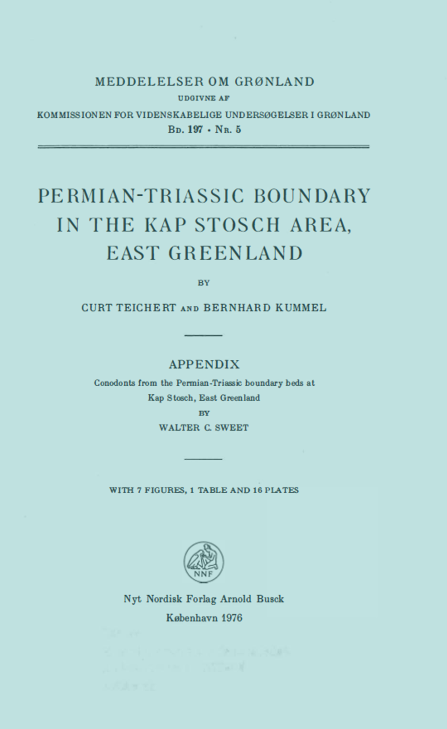Permian-triassic Boundary in the Kap Stosch area, East Greenland.
DOI:
https://doi.org/10.7146/mog.v197.147767Abstract
Study of several Permian-Triassic sections in the Kap Stosch region of East Greenland (74°04' N. lat., 21°42.5' W. long.) in the summer of 1967 has provided a number of new observations. The Permian-Triassic sequence southwest of Kap Stosch consists of homogenous shale, silty shale, and siltstone. None of the rock units are highly indurated. Solifluction has so badly disturbed all outcrops that it is all but impossible to measure meaningful stratigraphic sections. The lowest Triassic beds in these regions do contain thin (1-5 cm) hard bands consisting of coquinas of ammonoids (Glyptophiceras and Otoceras) and containing fragments of bryozoans, productids, and other fossils of Permian affinities. Southeast of Kap Stosch, especially between Rivers 6 and 14, the lowest Triassic strata encompassing the Glyptophiceras Zone are about 200 meters thick. They are predominantly arkosic sandstone and conglomerate. A number of coarse sandstone and conglomerate beds yielded fragmentary as well as entire specimens of productid brachiopods, fragments of bryozoans, crinoid stems, and other Permian fossils, occurring to a distance of as much as 100 m above the base of the Triassic sequence. Thickness, sedimentary structures, and composition of the strata containing these mixed associations clearly indicate very rapid rates of deposition, leading us to the conclusion that during earliest Triassic time the "Permian" elements of the fauna almost certainly did not actually live in places where they are found. The underlying Permian formations are of diverse facies, including richly fossiliferous biohermal banks which are close to the study area. Some of these banks weather easily, yielding almost perfectly preserved fossils when freed of matrix. We consider it most probable that the majority of fossils were washed out of soft rocks and were badly broken during transportation. Some of the Permian fossils in the lowest Triassic formations were transported in clay balls that, once coming to rest, dissolved, leaving well preserved fossils that were then transported very little, and were rapidly buried in the coarse sediment. We conclude that the Permian-Triassic sequence in the area encompasses a break equivalent to at least the Changhsingian Stage.

Downloads
Published
How to Cite
Issue
Section
License
Coypyright by the authors and the Commision for Scientific Research in Greenland. No parts of the publications may be reproduced in any form without the written permission by the copyright owners.

